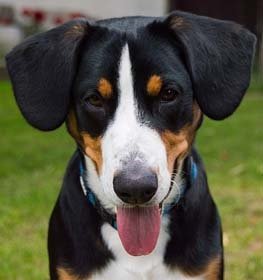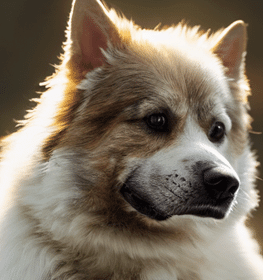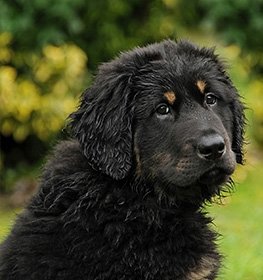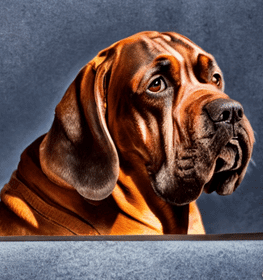Argentine Dogo Information & Dog Breed Facts
Collection of all the general dog breed info about Argentine Dogo so you can get to know the breed more.
| Group | Guard Dogs |
|---|---|
| Popularity Rank | 390 |
| Reviews | 6 |
| User Ratings | |
|
Compare the Argentine Dogo With Other Dogs
Select at least one dog breed to make the comparsion. | |
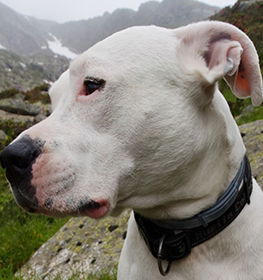 | |
| Origin | |
|
Common Names & Aliases
What other names is an Argentine Dogo known by? Discover all traditional, regional and informal names used for this breed. | Argentine MastiffArgentine Dog |
|---|---|
|
Breed Classification
What type of dog breed is an Argentine Dogo? Learn about its genetic classification and breeding category. | Purebred |
|
Size Classification
What size category is an Argentine Dogo? Learn how big the Argentine Dogo breed typically grows. | Large |
|---|---|
|
Weight Statistics
How much does an Argentine Dogo weigh? Discover typical weight ranges for adult males and females of the Argentine Dogo breed. | Male: 88-99 pounds (40-45 kg), Female: 71-77 pounds (32-35 kg) |
|
Average Weight
What is the average weight of an Argentine Dogo? | Male: 93.5 pounds (42.5 kg), Female: 74 pounds (33.5 kg) |
|
Height
How tall is the Argentine Dogo? Argentine Dogo height: | Male: 24-27 inches (64-68 cm), Female: 23-25 inches (60-64 cm) |
|
Average Height
What is the average height of an Argentine Dogo? | Male: 25.5 inches (66 cm), Female: 24 inches (62 cm) |
|
Price Range
How much does an Argentine Dogo puppy cost? Find current market prices and factors affecting Argentine Dogo costs. | $2800-$5000 If you choose to purchase the Argentine Dogo, you should know that the mentioned amount of money is an average of the collected data from breeders’ sites and puppy finder places. If you have a Argentine Dogo for sale, please advertise it on a reliable website to make sure the Argentine Dogo gets to a happy place. |
|---|---|
|
Availability
How easy is it to get a Argentine Dogo? How many Argentine Dogo are there in the world? | Average: The Argentine Dogo is a commonly available dog breed. There is less risk of overbreeding compared to the very popular dogs. Of course, they may be more popular in some countries, and inbreeding may occur, so be careful. |
|
Intelligence Rating
How intelligent is an Argentine Dogo? Discover the Argentine Dogo's intelligence ranking and learning capabilities. | Smart: The Argentine Dogo dogs have great intelligence. They understand and memorize new commands in 15-25 repetitions.
The Argentine Dogo is among the smartest dogs in the intelligence ranking. |
|---|---|
|
Training Difficulty
How easy is it to train an Argentine Dogo? Learn about the Argentine Dogo's trainability and response to training methods. | Argentine Dogo dogs are quite easy to train. Sometimes they can be challenging, but if you're consistent in teaching new commands they will obey for sure. |
|
Watchdog Rating
How good is an Argentine Dogo as a watchdog? Learn about the Argentine Dogo's alertness and guarding instincts. | Argentine Dogo dogs are one of the best watchdogs. Their main job is to observe and they're very consistent in their effort. The best vocal cords and sense of hearing belong to them. Usually, they're very territorial and protective about their property, so the Argentine Dogo dogs will alert you if they sense something different. |
|
Territorial Protection
Is an Argentine Dogo protective of its territory? Learn about the Argentine Dogo's guarding instincts and behavior. | Argentine Dogo dogs are extremely protective guard dogs. This breed doesn't hesitate to protect its territory so the Argentine Dogo can be a good choice if you want an excellent guard dog. Keep calm and the Argentine Dogo will take care of unwanted people or animals. |
|
Personality Traits
What personality does an Argentine Dogo have? Learn about characteristic Argentine Dogo temperament and behavior traits. | LovingProtectiveLoyalSociableTolerant |
|---|---|
|
Sensitivity Level
How sensitive are they? Argentine Dogo sensitivity: | Argentine Dogo dogs have an average emotional level and are not the most sensitive dog breed. Sometimes it's okay to change the daily routine, have guests and listen to loud music.
Some dogs handle moderate punishment very well, while others crumble apart at a dirty look. This breed is not affected emotionally by moderate punishment. |
|
Affection Level
How affectionate are they? Is an Argentine Dogo a good family dog? | Average: Argentine Dogo dogs are average dogs regarding their affection level. Some breeds are forthcoming and friendly, while others are independent and don't bond too closely with their owners. |
|
Social Needs
How much social interaction does the Argentine Mastiff need? Argentine Dogo social needs: | Argentine Dogo dogs need for social interaction is average. This breed likes being around people or other animals, but they don't mind being left alone for a few hours either. |
|
Impulse to Wander or Roam
How likely is the Argentine Dogo to run away? Does this breed explore or wander a lot? Does Argentine Dogo roam? | The wanderlust potential of the Argentine Dogo is strong enough to escape from home. They have a strong desire for exploring the world. Safer to walk them on a leash unless you teach them how to get back to you on command. |
|
Prey Drive
Do this canine have a strong prey drive? Does Argentine Dogo have high prey drive? | Argentine Dogo dogs have a high impulse to chase and catch something. Cats or any other small animals are in danger. It's a natural instinct, doesn't necessarily mean that Argentine Dogo dogs are aggressive. Better to keep this breed on a leash. |
|
Barking Frequency
Does an Argentine Dogo bark a lot? Learn about typical Argentine Dogo vocalization patterns and triggers. | Low to Average: The Argentine Dogo rarely barks. This breed could be a good choice if you're looking for a quiet breed. They don't bark unless there is a good reason.
Top reasons for barking: protection, alarm, fear, boredom, attention-seeking, greeting, separation anxiety, compulsive barking. |
|---|---|
|
Playful Nature
How playful is an Argentine Dogo? Understand the typical play drive and energy level of the Argentine Dogo breed. | Average: Argentine Dogos, like any other dog breed, like playing. Sometimes they bark in excitement for playing, but they are not the most playful dog breed. |
|
Apartment Adaptability
Can an Argentine Dogo live in an apartment? Learn about the Argentine Dogo's suitability for apartment living. | Not an apartment-friendly dog the Argentine Dogo breed. If you don't have a garden, think carefully about your decision, keeping Argentine Dogo indoors can cause a lot of problems. |
|
Lifestyle Adaptability
How adaptable is an Argentine Dogo to lifestyle changes? Learn about the Argentine Dogo's flexibility to new situations. | Average: Argentine Dogo dogs adapt to lifestyle changes and different living environments quite okay usually. |
|---|---|
|
Alone Time Tolerance
Can an Argentine Dogo be left alone? Learn about the Argentine Dogo's tolerance to solitude. | Just like every puppy, they are prone to panic, cry, bark, whine when they left alone by their owner. With proper socialization and quality time with the dog can solve this problem. |
|
Bite Risk Assessment
What is an Argentine Dogo biting potential? Learn about the Argentine Dogo's bite risk factors. | Low 🔽 The Argentine Dogo has a low chance of biting somebody. Top reasons for dog bite: protection, pain, excitement, herding instinct, being provoked. (Data based on the available online bite statistics.) |
|---|---|
|
Mouthing Tendency
Is an Argentine Dogo mouthy? Learn about the Argentine Dogo's tendency to use mouth during play. | Argentine Dogo dogs have a lower than average tendency to nip, chew, playbite, or herd people. It's a common habit during puppyhood, not aggressive behavior. These "bites" don't hurt, but Argentine Dogo dogs need to be taught a good attitude. |
|
Bite Strength Rating
How strong is an Argentine Dogo bite? Learn about the Argentine Dogo's bite force measured in PSI. | Above 400 PSI 🔼 Argentine Dogo bite force: The Strongest. The Argentine Dogo bite force is among the strongest in the canine world. The bite force Argentine Dogo measurements are typically quite high, which is a testament to their powerful and large stature. The bite force of Argentine Dogo dogs is impressive, and their Argentine Dogo bite PSI is reflective of their powerful nature.
The Argentine Dogo PSI bite should be respected, and appropriate precautions should be taken when interacting with these dogs. The PSI of an Argentine Dogo bite is high, making them one of the strongest breeds in terms of bite force. They are very protective of themselves and their families, therefore a dog bite from them could be exceptionally dangerous with their PSI being above 400. To ensure a well-behaved and controlled dog, it's important to learn how to train an Argentine Dogo puppy not to bite from an early age. It is important that they’re trained to be around others safely. |
|
Average Lifespan
How long does an Argentine Dogo live? Learn about the typical lifespan of the Argentine Dogo breed. | 10-12 years The average lifespan of Argentine Dogo: 11 years |
|---|---|
|
Climate Tolerance
How well does an Argentine Dogo handle different weather? Learn about the Argentine Dogo's climate adaptability. | Prefers average to warm weather conditions Different dogs have different preferences when it comes to weather conditions. However, in general, most dogs prefer average to warm weather conditions, as they typically find hot weather conditions to be uncomfortable and taxing. |
|
Health Concerns
What health issues are common in an Argentine Dogo? Discover typical conditions affecting the Argentine Dogo breed. | Argentine Dogos tend to have more frequent health issues than other breeds. Regular vet check-ups are needed.
|
|
Vet Care Frequency
How often does an Argentine Dogo need vet visits? Learn about the Argentine Dogo's veterinary care requirements. | Frequent The Argentine Dogo should have a complete physical check-up at least once (but preferably twice) per year. If your dog shows any symptoms, call your veterinarian. |
|
Health Problems
What genetic/health problems does the Argentine Dogo breed have? What are the health issues and concerns of the Argentine Dogo breed? Most common health risks of Argentine Dogo: | Hip Dysplasia AllergiesCancerHypothyroidismDeafness |
|
Energy Rating
How energetic is an Argentine Dogo? Understand daily activity needs of the Argentine Dogo breed. | Argentine Dogo dogs have a higher energy level than other dog breeds. If you want a dog for snuggling on the couch, this breed isn't the perfect choice for you. |
|---|---|
|
Activity Requirement / Exercise Need
How much exercise does an Argentine Dogo need? How much exercise do Argentine Dogo dogs require per day?
Do Argentine Dogo dogs need a lot of exercises? | Argentine Dogo dogs need quite a lot of exercise. Daily walks should be on schedule. If you live an active life, this breed can be a good choice for you. |
|
Sleeping Need
How much sleep does the Argentine Dogo breed need? | Argentine Dogo dogs are quite energetic dogs and they don't spend too much time with sleeping. If you live an active life, this breed can be a good choice for you. |
|
Obesity Tendency
Is an Argentine Dogo prone to weight gain? Learn about the Argentine Dogo's obesity risks. | Low to Average: The Argentine Dogo has a low to the average risk for obesity. To make your dog happy and fit, feed him with quality dry dog food and live an active life together. Try to find the happy medium between exercise and feeding.
If you notice any weight gain, consult your veterinarian and make a diet plan. Reduce unhealthy food and snacks, and measure the Argentine Dogo weight regularly. |
|---|---|
|
Food Consumption
How much food does an Argentine Dogo need daily? Learn about the Argentine Dogo's feeding requirements. | 6 to 8 cups of high-quality dry food a day, divided into two meals. |
|
Allergy Friendliness
Is an Argentine Dogo hypoallergenic? Learn about the Argentine Dogo's suitability for allergy sufferers. | No Argentine Dogo dogs don't do well with allergy sufferers by causing allergic reactions. Some dog breeds are even considered to higher possibility of an allergic response. Coat type isn't necessarily relevant, because most people are allergic to dander (flakes on the dog's skin) or saliva, not actually to dog hair. |
|---|---|
|
Coat Colors
What colors does an Argentine Dogo come in? Discover all possible Argentine Dogo color variations. | White |
|
Grooming Requirements
How much grooming does an Argentine Dogo need? Learn about Argentine Dogo coat maintenance requirements. | Easy to groom: The Argentine Dogo doesn't require a lot of grooming. Seasonal flea treatment is needed, but cutting the dog's hair by a professional groomer isn't necessary. Ears and eyes should be cleaned regularly to avoid infections. Argentine Dogo is a good choice if you don't have the time, skill, or money to take care of a high-maintenance dog. Recommended for beginners. |
|
Drooling Tendency
Does an Argentine Dogo drool a lot? Learn about the Argentine Dogo's drooling habits. | The Argentine Dogo is an average drooler. Drooling is the unintentional saliva flowing outside of the mouth. It can be completely normal or a sign of a health problem.
If you notice any change in your dog's drooling habit, you should contact a vet as soon as possible. |
|
Stinkiness Rating
Does an Argentine Dogo smell bad? Learn about the Argentine Dogo's natural odor levels. | Medium ⏺ The Argentine Dogo has an average chance of bad smell. Top reasons for dog stinkiness: infection of bad tooth/ear/skin folds, gas attacks. |
|
Coat Characteristics
What type of coat does an Argentine Dogo have? Learn about the Argentine Dogo's fur characteristics. | Fine |
|
Bathing Needs
How often does an Argentine Dogo need baths? Learn about the Argentine Dogo's bathing requirements. | 3-4 weeks More often than average. These dog coats tend to be longer, softer, and oilier than short-haired breeds. While a good bath every now and then is a great way to keep your buddy from becoming overly smelly, be mindful about overbathing.
Bathing will wash away your dog’s natural oils, while a simple brushing every few days should keep them clean. |
|
Shedding Level
How much do Argentine Dogo dogs shed? How to control, reduce and prevent the shedding of the Argentine Mastiff? Do Argentine Dogo dogs shed a lot? | Argentine Dogo dogs shed moderately. It's a natural process of the hair growth cycle. Regular brushing reduces the amount of hair that sheds. It mostly depends on their health status and breed type. |
|
Child Compatibility
Is an Argentine Dogo good with children? Learn about the Argentine Dogo's behavior around kids of different ages. | Argentine Dogo dogs are average friendly dogs towards children. |
|---|---|
|
Pet Compatibility
How well does an Argentine Dogo get along with other pets? Discover the Argentine Dogo's compatibility with other animals. | Argentine Dogo dogs do best when they’re the only pet at the family. |
|
Stranger Friendly
Are they aggressive or friendly towards/with strangers? Argentine Dogo temperament with other people: | Argentine Dogo dogs are not stranger friendly dogs. |
|
Cat Friendly
How well do Argentine Dogo dogs get along with cats? Are they good with kittens? What is this fido's temperament with cats? Can they be good with cats? Can the Argentine Dogo breed live with a cat? | Argentine Dogo dogs are not cat-friendly dogs. |
|
Dog Friendly
Is Argentine Dogo good with other dogs? Are they dog-friendly dogs? How well do Argentine Dogo dogs get along with other dogs? | Argentine Dogo dogs are not dog-friendly. If you want more dogs in your family or you'd like to join dog meetups, the Argentine Dogo is not the best choice. |
|
Good For First Time Owners
Is Argentine Dogo breed good for first-time owners? Do they make a good dog for novice owners? Is Argentine Dogo breed suitable for first-time owners? | Yes Argentine Dogo dogs are good for novice owners, due to their easy-going personality. |
|
Office Friendly
Are Argentine Dogo dogs good office canines? Do Argentine Dogo dogs make good office-friendly pets? Can they be office dogs? | No Argentine Dogo is not the best dog breed for office environment. |
|
Senior Citizens Friendly
Are they senior citizens friendly dogs? How well do Argentine Dogo dogs get along with the elderly people? What is the Argentine Mastiff temperament with senior people? Are Argentine Dogo dogs good for elderly owners? | Argentine Dogos are commonly okay with elderly people. |
|
Service Dog Capability
Can an Argentine Dogo be a service dog? Learn about the Argentine Dogo's service work potential. | Not really This breed generally not used as a service dog. A service dog is a term used in the USA to refer to any type of assistance dog specifically trained to help people who have disabilities, such as visual impairment, hearing impairments, mental disorders, seizures, mobility impairment, and diabetes. Service dogs are protected under the ADA (Americans with Disabilities Act).
Argentine Dogo is not the best breed for service purposes. |
|---|---|
|
Therapy Work Suitability
Is an Argentine Dogo good as a therapy dog? Learn about the Argentine Dogo's therapy work aptitude. | Not really This breed is generally not used as a therapy dog. A therapy dog is a dog that might be trained to provide affection, comfort, and love to people in hospitals, retirement homes, nursing homes, schools, hospices, disaster areas, and people with anxiety disorders or autism.
Argentine Dogo is not the best breed for therapeutic purposes. |
|
Scent Detection Ability
Is an Argentine Dogo good at detection work? Learn about the Argentine Dogo's scenting abilities. | Not really They are not typically employed for this type of work, but there may be exceptional cases. A detection dog or sniffer dog is a dog that is trained to use its senses (mostly its smell) to detect substances such as explosives, illegal drugs, wildlife scat, currency, blood, and contraband electronics such as illicit mobile phones.
Argentine Dogo is not the best breed for detection purposes. |
|
Search & Rescue Potential
Can an Argentine Dogo do search and rescue? Learn about the Argentine Dogo's SAR capabilities. | Not really This dog breed is not typically used as a search and rescue dog. The use of dogs in search and rescue (SAR) is a valuable component in wilderness tracking, natural disasters, mass casualty events, and locating missing people.
The Argentine Dogo is not the best breed for SAR purposes. |
|
Maritime Work Ability
Is an Argentine Dogo good on boats? Learn about the Argentine Dogo's maritime capabilities. | Not really Argentine Dogo breed usually doesn't like being on a boat. Boat dogs were typically bred for their strength, stamina, and water resistance, as they were often required to perform tasks such as pulling in fishing nets, and jumping into the water to retrieve ropes or lines, or helping to move cargo. Sailor dog is a type of dog that was bred to accompany sailors on their voyages. They were typically used for three purposes: as a working dog, a watchdog, and as a companion. A boat dog is a term used to describe a type of dog that was traditionally bred and used as a working dog on boats. |
|
Draft Work Capability
Can an Argentine Dogo pull carts? Learn about the Argentine Dogo's drafting abilities. | Yes A drafting dog or draft dog is a dog bred and used for cart pulling. Dogs bred for this work have strong builds and qualities that are needed, strength and determination.
Argentine Dogo breed is a good choice for drafting purposes. |
|
Military Service Background
Was an Argentine Dogo used in military service? Learn about the Argentine Dogo's military history. | Yes In history, this breed was unfortunately used for combat dogs. A combat dog is a specially trained dog that is used in warfare to help protect military personnel and assets. Combat dogs are often deployed in areas where there is potential for contact with the enemy, such as during raids or search operations.
Combat dogs are typically assigned to either infantry or special operations units. They are used for a variety of tasks including area security, sentry duty, trackers, and explosive detection. In addition to their combat roles, combat dogs also play an important role in troop morale by providing companionship and emotional support. |
|
Puppy Litter Size
How many puppies does an Argentine Dogo usually have? Learn about typical litter sizes. | 4-8 puppies |
|---|---|
|
Pregnancy Duration
How long is an Argentine Dogo pregnant? Learn about the Argentine Dogo's gestation period. | 60-64 days Reproductive cycle of the female Argentine Dogo: The first period called Proestrus lasts for about 9 days.
During this time the females start to attract males. You can notice by swelling vulva and bloody discharge. The second part is the Estrus when the female is receptive for the male. It lasts for about 3 to 11 days. The sign of the proestrus part is the soft and enlarged vulva. The discharge decreases and lightens in color. The third part is the Diestrus. Normally, it occurs around day 14. In this period the female’s discharge changes for vivid red and coming to its end. The vulva returns to average, and she will no longer permit mating. The fourth part called the Anestrus. The time frame between heat periods normally lasts about six months. |
|
Breeding Frequency
How often can an Argentine Dogo have puppies? Learn about safe breeding intervals. | Once a year. More frequent breeding is not healthy. It is very important not to buy a dog from a puppy mill, where the needs of the pups and their mothers are ignored. It's an inhumane high-volume dog breeding facility, where puppies born several times a year. |
|
AKC Classification
What AKC group is an Argentine Dogo in? Learn about the Argentine Dogo's AKC classification. | Recognized by the American Kennel Club as a Miscellaneous breed. |
|---|---|
|
FCI Classification
What FCI group is an Argentine Dogo in? Learn about the Argentine Dogo's international classification. | Not recognized by FCI. |
|
Kennel Club Recognition
Which kennel clubs recognize an Argentine Dogo? Learn about the Argentine Dogo's official recognition. | American Canine RegistryAmerican Kennel ClubAmerica's Pet RegistryDog Registry of America Inc.Federation Cynologique InternationaleNorth American Purebred Registry, Inc.American Canine Association, Inc.National Kennel ClubBackwoods Bulldog ClubFederacion Cinologica Argentina |
Argentine Dogo Pros and Cons
- Intelligence Rating: Smart: The Argentine Dogo dogs have great intelligence.
- Grooming Requirements: Easy to groom: The Argentine Dogo doesn't require a lot of grooming.
- Obesity Tendency: Low to Average: The Argentine Dogo has a low to the average risk for obesity.
- Watchdog Rating: Argentine Dogo dogs are one of the best watchdogs.
- Mouthing Tendency: Argentine Dogo dogs have a lower than average tendency to nip, chew, playbite, or herd people.
- Good For First Time Owners: Argentine Dogo dogs are good for novice owners, due to their easy-going personality.
- Draft Work Capability: A drafting dog or draft dog is a dog bred and used for cart pulling.
- Health Concerns: Argentine Dogos tend to have more frequent health issues than other breeds.
- Allergy Friendliness: Argentine Dogo dogs don't do well with allergy sufferers by causing allergic reactions.
- Apartment Adaptability: Not an apartment-friendly dog the Argentine Dogo breed.
- Impulse to Wander or Roam: The wanderlust potential of the Argentine Dogo is strong enough to escape from home.
- Cat Friendly: Argentine Dogo dogs are not cat-friendly dogs.
- Dog Friendly: Argentine Dogo dogs are not dog-friendly.
- Office Friendly: Argentine Dogo is not the best dog breed for office environment.
Argentine Dogo History
The Dogo Argentino, as its name already suggests, can trace its origins back to Cordoba, in the Central part of Argentina. The development process of the breed is pleasingly easy to trace back, thanks to the documentation and records about the breed’s evolution.
The Argentine Dogo was created in 1928, by a doctor and breeder named Dr. Antonio Nores Martinez. The breed is a direct descendant of the now-extinct Cordoba Fighting Dog, which was developed from Bull and Mastiff-type breeds. The breeder’s work was based on the methodical cross-breeding of multiple purebreds with the long-existing Cordoba Fighting Dog. Dr. Martinez crossed the Cordoba Fighting Dog with other breeds, with the intention of developing a new breed that is as courageous and strong as the Cordoba Fighting Dog, while being superior in almost every other sense, and being less aggressive than its predecessors. He used a huge variety of breeds, as the DNA base for the Argentine Dogo, and he never failed to document each mating process. The Irish Wolfhound provided stature, the Great Dane was included to add jaw strength and height, the English Bulldog and the Bull Terrier provided the boldness and pluck, the Boxer was added to provide good nature and faithfulness, the Dogue de Bordeaux was introduced for its large head, the Great Pyrenees was added to obtain the homogenous white color, and the Spanish Mastiff was introduced because of its robust physique. After a thorough behavioural and character selection, throughout different generations, Dr. Martinez achieved the goal he set out, when the first litter of Argentine Dogo was born.
The Argentine Dogo was fully established in 1947. In the same year, Dr. Martinez entered into a fight with a boar and a cougar, in which the dog had won. For the reason that the tournament was filmed, the dogs’ notoriety ensured their popularity in their native country, Argentina, as well as in other South-American countries. Their popularity grew, even more, when people started to realize that Dr. Martinez has managed to develop a trustworthy, loyal companion with a muscular built and a strong prey drive, which is a perfect fit for all kinds of hunting in the rugged environment of Argentina. The Argentine Kennel Club recognized the breed in 1964, thus the Argentine Dogo’s international popularity began to grow. The FCI (Fédération Internationale Cynologique) registered the Argentine Dogo in 1973, as the first and only dog breed that is indigenous to Argentina. However, the AKC gave the breed recognition much later, in 2000.
The Argentine Dogo is an incredibly versatile breed, nowadays they both fulfill their initial role as a hunting companion and guarding dog, and also, they are kept as family pets. Many of the breed’s specimens are employed by the military as personal protection, search and rescue dogs, but the breed also can be seen alongside physically disabled or blind people, as therapy or helping dogs. Even though the breed has many advocates, it is banned in several countries including Norway, the UK, and Australia, because of their reputation of being aggressive towards animals and humans, thus being a potentially deadly risk for all. This was a controversial decision in every country, many critics claimed that the breed is rarely aggressive, if taught and socialized adequately from a very young age.
Latest Argentine Dogo Compares
Argentine Dogo Names
How old is my Argentine Dogo in human years?
You May Also Like
Rate The Argentine Dogo Breed
Argentine Dogo Comments, Reviews and Questions
- guatemalan dogo lover
Sep 27, 2023, 1:38:04 PM:
very mid! do not buy
- bad stephen
Sep 27, 2023, 1:35:24 PM:
these dogs are terrible! get a guatemalan dogo instead
- Rigo
Sep 27, 2023, 1:34:43 PM:
- Donald T.
Sep 27, 2023, 1:34:26 PM:
Bad! Get them back where they come from
- Rigo
Sep 27, 2023, 1:34:20 PM:
- Sadikov
Mar 20, 2020, 11:28:31 PM:
My Dogo Argentino is highly dog/pet/stranger friendly since she grow up with cats and visit a dogs parks pretty often. She are sleeping more than 12 hours and pretty lazy. She loves grooming and totally a therapy Dog

